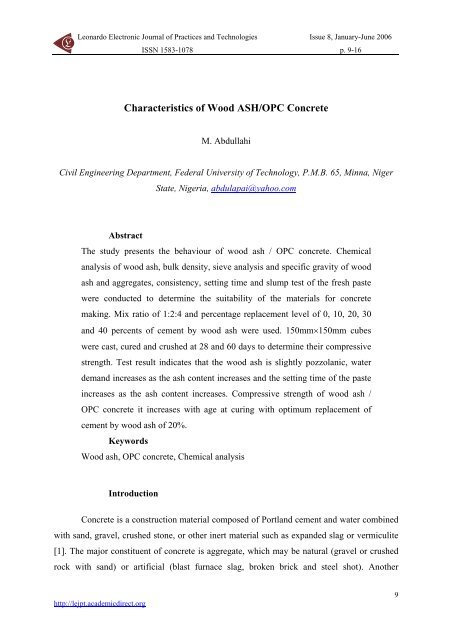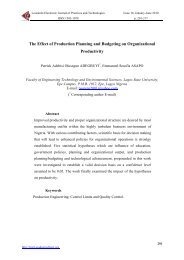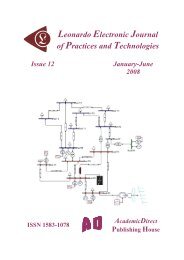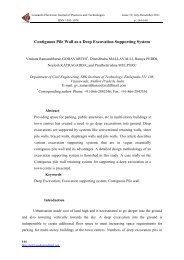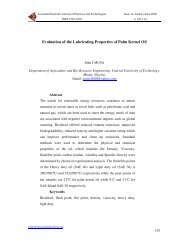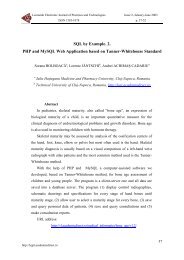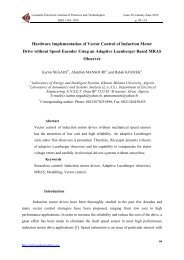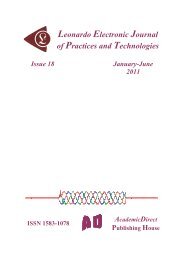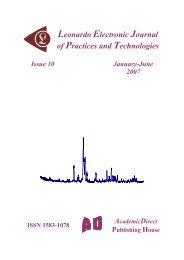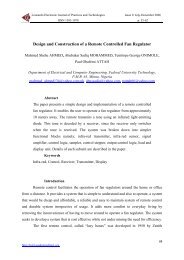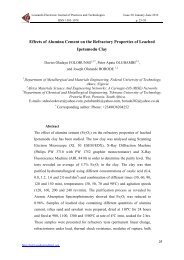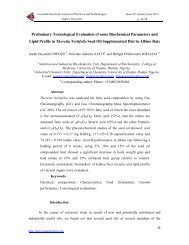Characteristics of Wood ASH/OPC Concrete - Leonardo Electronic ...
Characteristics of Wood ASH/OPC Concrete - Leonardo Electronic ...
Characteristics of Wood ASH/OPC Concrete - Leonardo Electronic ...
Create successful ePaper yourself
Turn your PDF publications into a flip-book with our unique Google optimized e-Paper software.
<strong>Leonardo</strong> <strong>Electronic</strong> Journal <strong>of</strong> Practices and Technologies<br />
ISSN 1583-1078<br />
http://lejpt.academicdirect.org<br />
<strong>Characteristics</strong> <strong>of</strong> <strong>Wood</strong> <strong>ASH</strong>/<strong>OPC</strong> <strong>Concrete</strong><br />
M. Abdullahi<br />
Issue 8, January-June 2006<br />
p. 9-16<br />
Civil Engineering Department, Federal University <strong>of</strong> Technology, P.M.B. 65, Minna, Niger<br />
State, Nigeria, abdulapai@yahoo.com<br />
Abstract<br />
The study presents the behaviour <strong>of</strong> wood ash / <strong>OPC</strong> concrete. Chemical<br />
analysis <strong>of</strong> wood ash, bulk density, sieve analysis and specific gravity <strong>of</strong> wood<br />
ash and aggregates, consistency, setting time and slump test <strong>of</strong> the fresh paste<br />
were conducted to determine the suitability <strong>of</strong> the materials for concrete<br />
making. Mix ratio <strong>of</strong> 1:2:4 and percentage replacement level <strong>of</strong> 0, 10, 20, 30<br />
and 40 percents <strong>of</strong> cement by wood ash were used. 150mm×150mm cubes<br />
were cast, cured and crushed at 28 and 60 days to determine their compressive<br />
strength. Test result indicates that the wood ash is slightly pozzolanic, water<br />
demand increases as the ash content increases and the setting time <strong>of</strong> the paste<br />
increases as the ash content increases. Compressive strength <strong>of</strong> wood ash /<br />
<strong>OPC</strong> concrete it increases with age at curing with optimum replacement <strong>of</strong><br />
cement by wood ash <strong>of</strong> 20%.<br />
Keywords<br />
<strong>Wood</strong> ash, <strong>OPC</strong> concrete, Chemical analysis<br />
Introduction<br />
<strong>Concrete</strong> is a construction material composed <strong>of</strong> Portland cement and water combined<br />
with sand, gravel, crushed stone, or other inert material such as expanded slag or vermiculite<br />
[1]. The major constituent <strong>of</strong> concrete is aggregate, which may be natural (gravel or crushed<br />
rock with sand) or artificial (blast furnace slag, broken brick and steel shot). Another<br />
9
10<br />
<strong>Characteristics</strong> <strong>of</strong> <strong>Wood</strong> <strong>ASH</strong>/<strong>OPC</strong> <strong>Concrete</strong><br />
M. Abdullahi<br />
constituent is the binder, which serves to hold together the particles <strong>of</strong> aggregate to form<br />
concrete. Commonly used binder is the product <strong>of</strong> hydration <strong>of</strong> cement, which is the chemical<br />
reaction between cement and water [2]. Admixtures may also be added to concrete mixes to<br />
change some <strong>of</strong> its properties.<br />
<strong>Wood</strong> ash in this study is an admixture: a pozzolana. A pozzolana is a material rich in<br />
silica and alumina which in itself has little or no cementitious value but will, in finely divided<br />
form and in the presence <strong>of</strong> moisture, chemically react with calcium hydroxide at ordinary<br />
temperatures to form compounds possessing cementitious properties [3]. <strong>Wood</strong> ash is<br />
obtained from the combustion <strong>of</strong> wood. It can be related to fly ash since fly ash is obtained<br />
from coal, which is a fossilized wood [4]. Rice husk ash is also <strong>of</strong> plant origin. This implies<br />
that wood ash could be used as a pozzolana in concrete. Tarun, Rudolph and Rafat [5]<br />
reported the following elements in wood ash: carbon (5% to 30%), calcium (5% to 30%),<br />
carbon (7% to 33%), potassium (3% to 4%), magnesium (1% to 2%), phosphorus (0.3% to<br />
1.4%) and sodium (0.2% to 0.5%). The following compound composition limits were also<br />
reported: SiO2 (4% to 60%), Al2O3 (5% to 20%), Fe2 O3 (10% to 90%), CaO (2% to 37%),<br />
MgO (0.7% to 5%), TiO2 (0% to 1.5%), K2O (0.4% to 14%), SO3 (0.1% to 15%), LOI (0.1%<br />
to 33%), moisture content (0.1% to 22%), and available alkalis (0.4% to 20%). The study<br />
revealed that all the major compounds present in wood ash are present in fly ash.<br />
Materials and Methods<br />
The wood ash used in this work was powdery, amorphous solid, sourced locally, from<br />
a bakery in Minna. The wood ash was passed through BS sieve 0.075mm size. The chemical<br />
composition <strong>of</strong> the wood ash was conducted at the Agric. Laboratory <strong>of</strong> Federal University <strong>of</strong><br />
Technology, Minna, Nigeria. Bulk density, sieve analysis and specific gravity tests were<br />
conducted on the ash, fine and coarse aggregates in accordance to [6] and [7].<br />
The mix used for all concrete cubes cast in this work is 1:2:4, with the cement<br />
partially replaced by wood ash in varied percentages <strong>of</strong> its volume (0%, 10%, 20%, 30% and<br />
40%). The workability <strong>of</strong> each <strong>of</strong> the mixes was determined using slump test according to [8].<br />
Cubes were cast using wooden moulds (150mm×150mm) and compaction was done<br />
manually. The cubes were cured and crushed to determine their compressive strength at 28<br />
and 60 days according to [9].
<strong>Leonardo</strong> <strong>Electronic</strong> Journal <strong>of</strong> Practices and Technologies<br />
ISSN 1583-1078<br />
Results and Discussions<br />
Issue 8, January-June 2006<br />
p. 9-16<br />
Chemical Analysis <strong>of</strong> <strong>Wood</strong> Ash<br />
The results <strong>of</strong> chemical analysis <strong>of</strong> wood ash are shown in Table 1. The total<br />
percentage composition <strong>of</strong> Iron oxide (Fe2O3 = 2.34%), aluminium oxide (Al2O3 = 28.0%) and<br />
silicon dioxide (SiO2 = 31.80%) was found to be 62.14%. This is less than 70% minimum<br />
required for pozzolana [3] (ASTM C 618-94, 1994).<br />
Table 1. Chemical Composition <strong>of</strong> <strong>Wood</strong> Ash<br />
Constituent SiO2 Al2O3 Fe2O3 CaO MgO K2O NaO L.O.I<br />
Composition [%] 31.8 28 2.34 10.53 9.32 10.38 6.5 27<br />
This reduces the pozzolanicity <strong>of</strong> the wood ash. The percentage composition <strong>of</strong> silicon<br />
dioxide (31.8%) is within the range specified by [5]. However, the percentage composition <strong>of</strong><br />
Iron oxide and aluminium oxide were not in agreement with the work [5]. The loss on ignition<br />
obtained was 27%. The value is more than 12% maximum as required for pozzolana [3]. This<br />
means that the wood ash contain appreciable amount <strong>of</strong> un-burnt carbon which reduces its<br />
pozzolanic activity. The un-burnt carbon is not pozzolanic and its presence serves as filler to<br />
the mixture. The alkali content (Na2O) was found to be 6.5%. This value is higher than the<br />
maximum alkali content <strong>of</strong> 1.5% required for pozzolana. The alkali content is important were<br />
the wood ash is to be used with reactive aggregate [10]. <strong>Wood</strong> ash will not be suitable for<br />
construction work where reactive aggregate is to be used.<br />
Specific Gravity Test<br />
Table 2 shows the result for the specific gravity test <strong>of</strong> aggregates and wood ash. The<br />
specific gravity <strong>of</strong> wood ash was found to be 2.13. This value is far less than 3.15 for Portland<br />
cement.<br />
The value is close to the value reported by [11] and [12] which was 2.13 for rice husk<br />
ash and 2.12 for acha husk ash.<br />
It is also within the range for the specific gravity <strong>of</strong> pulverized fuel ash [10]. The<br />
specific gravity <strong>of</strong> the sand and gravel were found to be 2.62 and 2.66.<br />
The value obtained falls within the limit for natural aggregates with value <strong>of</strong> specific<br />
gravity between 2.6 and 2.7 as reported in [10].<br />
11
12<br />
<strong>Characteristics</strong> <strong>of</strong> <strong>Wood</strong> <strong>ASH</strong>/<strong>OPC</strong> <strong>Concrete</strong><br />
M. Abdullahi<br />
Data<br />
Table 2. Specific Gravity <strong>of</strong> Materials<br />
<strong>Wood</strong> Ash Sand<br />
Test1 Test 2 Test1 Test2<br />
Gravel<br />
Test 1 Test2<br />
Mass <strong>of</strong> gas jar, plate,<br />
soil (RHA) and water (m3) [g]<br />
1595.0 1599.0 1685 1678 1732.90 1730.9<br />
Mass <strong>of</strong> gas jar, plate<br />
and soil (RHA) (m2) [g]<br />
686.6 689.4 820.0 815.5 876.5 875.5<br />
Mass <strong>of</strong> gas jar, plate<br />
and water (m4) [g]<br />
1504.6 1506.4 1495.9 1493.5 1507.1 1506.9<br />
Mass <strong>of</strong> gas jar and plate (m1) [g] 515.6 515.6 515.6 515.6 515.6 515.6<br />
(m2 – m1) [g] 171.0 173.8 304.4 299.9 360.9 359.9<br />
(m4 – m1) [g] 989.0 990.8 980.3 977.9 991.5 991.3<br />
(m3 – m2) [g] 908.4 909.6 865.0 862.5 856.4 855.4<br />
(m4 – m1) - (m3 – m2) [g] 80.6 81.2 115.3 115.4 135.1 135.9<br />
Specific gravity <strong>of</strong> the particles Gs<br />
2.12<br />
= (m2 – m1)/((m4 – m1) - (m3 – m2))<br />
2.14 2.64 2.60 2.67 2.65<br />
Mean <strong>of</strong> specific gravity 2.13 2.64 2.66<br />
Bulk Density Test<br />
Table 3 shows the result for the compacted bulk density <strong>of</strong> wood ash and aggregates.<br />
The bulk density <strong>of</strong> wood ash was found to be 760 kg/m 3 .<br />
Table 3. Compacted Bulk Density <strong>of</strong> Materials<br />
Data<br />
<strong>Wood</strong> Ash Sand Gravel<br />
Test 1 Test 2 Test 1 Test 2 Test 1 Test 2<br />
Weight <strong>of</strong> empty cylinder (w1) [kg] 4.35 4.35 4.35 4.35 4.35 4.35<br />
Weight <strong>of</strong> empty cylinder + weight<br />
<strong>of</strong> compacted materials (w2) [kg]<br />
5.10 5.12 5.96 5.98 5.85 5.85<br />
Weight <strong>of</strong> compacted materials (w3) [kg] 0.75 0.77 1.61 1.63 1.5 1.5<br />
Volume <strong>of</strong> Cylinder (v) [Litre] 1 1 1 1 1 1<br />
Compacted Bulk density (w3/v) [Kg/m 3 ] 750 770 1610 1630 1500 1500<br />
Mean Bulk density [Kg/m 3 ] 760 1620 1500<br />
The [11] report obtained the compacted bulk density for rice husk ash to be 530 kg/m 3<br />
and [12] reported a value <strong>of</strong> 740 kg/m 3 for acha husk ash. These values are reasonably close<br />
to one another indicating that they are all lightweight materials. The silica in pozzolana can<br />
only combine with calcium hydroxide when it is in a finely divided state. Pozzolana in this<br />
state has uniform particles which are difficult to compact very closely resulting to a low<br />
compacted bulk density. The compacted bulk densities for sand and gravel were found to be<br />
1620 kg/m 3 and 1500 kg/m 3 .
<strong>Leonardo</strong> <strong>Electronic</strong> Journal <strong>of</strong> Practices and Technologies<br />
ISSN 1583-1078<br />
Sieve Analysis<br />
Tables 4 and 5 show the result for the sieve analysis <strong>of</strong> sand and gravel.<br />
Issue 8, January-June 2006<br />
p. 9-16<br />
Table 4. Sieve Analysis <strong>of</strong> Fine Aggregate<br />
Sieve Mass <strong>of</strong> Mass <strong>of</strong> Mass <strong>of</strong> Percentage Cumulative Percentage<br />
Size Sieve Sieve + Sample Sample Retained Retained Percentage Passing<br />
[mm] (w1) [g] (w2) [g] (w3) [g] [%] Retained [%] [%]<br />
5.00 478.60 483.10 4.50 0.90 0.90 99.10<br />
3.35 468.87 477.42 8.55 1.72 2.62 97.38<br />
2.36 435.99 459.34 23.35 4.67 7.29 92.71<br />
1.18 390.85 423.25 32.40 6.48 13.77 86.23<br />
0.60 337.30 438.30 101.00 20.20 33.97 66.03<br />
0.30 317.10 558.95 241.85 48.37 82.34 17.66<br />
0.15 296.01 302.06 6.05 1.21 83.55 16.45<br />
0.075 301.08 331.18 30.10 6.02 89.57 10.43<br />
Pan 295.53 347.68 52.15 10.43 100.00 0.00<br />
Sieve<br />
Size<br />
[mm]<br />
Table 5. Sieve Analysis <strong>of</strong> Coarse Aggregate<br />
Mass <strong>of</strong> Sample<br />
Retained<br />
[g]<br />
Percentage<br />
Retained<br />
[%]<br />
Cumulative<br />
Percentage<br />
Retained [%]<br />
Percentage<br />
Passing<br />
[%]<br />
28 0.00 0.00 0.00 100.00<br />
14 323.79 16.19 16.19 83.81<br />
10 1466.21 73.31 89.50 10.50<br />
6.3 166.12 8.31 97.81 2.19<br />
5.0 21.16 1.06 98.87 1.13<br />
Pan 22.70 1.13 100.00 0.00<br />
Test result reveal that the sand is fine grading sand and the gravel is single-sized<br />
aggregate <strong>of</strong> 14mm nominal size confirming the aggregates suitable for construction work<br />
[13].<br />
Consistency and Setting Times Tests<br />
Table 6 shows the result for the consistency test. Result reveals that the water demand<br />
increases with the wood ash content. The wood ash introduced into the cement increases the<br />
carbon content and this increases the water required to achieve a reasonable workability.<br />
Table 6. Consistency Test<br />
Replacement <strong>of</strong> Opc by Rha [%] 0 10 20 30 40<br />
Opc [g] 400 360 320 280 240<br />
Rha [g] 0 40 80 120 160<br />
Water [ml] 125 132 138 146 153<br />
Water/Binder Ratio [%] 31 33 35 37 38<br />
13
14<br />
<strong>Characteristics</strong> <strong>of</strong> <strong>Wood</strong> <strong>ASH</strong>/<strong>OPC</strong> <strong>Concrete</strong><br />
The result for the setting times test is shown in Table 7.<br />
Table 7. Setting Times Test<br />
Replacement <strong>of</strong> Opc by Rha [%] 0 10 20 30 40<br />
Initial Setting Time [minutes] 100 218 321 395 436<br />
Final Setting Time [minutes] 160 334 523 698 789<br />
M. Abdullahi<br />
The initial and final setting times increases with increase in wood ash content. The<br />
exothermic reaction between cement and water result into liberation <strong>of</strong> heat and evaporation<br />
<strong>of</strong> water and eventually hardening <strong>of</strong> the paste. The rate <strong>of</strong> reaction and quantity <strong>of</strong> heat<br />
liberated reduces with the introduction <strong>of</strong> wood ash leading to late stiffening <strong>of</strong> the paste. As<br />
the hydration process was prolonged, greater amount <strong>of</strong> water was required in the process.<br />
Slump Test<br />
The result for the slump test is shown in Table 8. Test result shows that mixes with<br />
greater wood ash content requires greater water content to achieve a reasonable workability.<br />
Table 8. Slump Values<br />
Replacement <strong>of</strong> Opc by Rha [%] 0 10 20 30 40<br />
Water/Binder Actual Ratio 0.6 0.66 0.67 0.68 0.69<br />
Slump [mm] 30 35 40 40 35<br />
The increased water demand was due to the relatively high carbon content in wood<br />
ash. The slumps observed were from low (15 to 30 mm) to medium (35 to 75 mm) [8].<br />
Compressive Strength Test<br />
Table 9 show the result for the compressive strength <strong>of</strong> wood ash / <strong>OPC</strong> concrete at 28<br />
and 60 days. The result shows that the cubes containing 0% wood ash had the highest<br />
compressive strength. The mix containing 20% wood ash had higher strength than that<br />
containing 10% wood ash at 28 and 60 days.<br />
This was due to the fact that the silica provided by 10% wood ash was inadequate to<br />
react with the calcium hydroxide produced by the hydration <strong>of</strong> cement. Increase in wood ash<br />
content beyond 20% resulted in a reduction in strength at 28 and 60 days. In this case the<br />
silica present in the mix was in excess <strong>of</strong> the amount required to combine with the calcium<br />
hydroxide from the hydrating cement. The excess silica had no pozzolanic value but only<br />
served as filler.
<strong>Leonardo</strong> <strong>Electronic</strong> Journal <strong>of</strong> Practices and Technologies<br />
ISSN 1583-1078<br />
Issue 8, January-June 2006<br />
p. 9-16<br />
Table 9. 28 and 60 day Compressive Strength<br />
Cube Weight Crushing Load Compressive Strength<br />
ash [Kg] [KN] [N/mm 2 Average<br />
]<br />
[N/mm 2 ]<br />
[%] 28 day 60 day 28 day 60 day 28 day 60 day 28 day 60 day<br />
A 7.84 7.86 535 498 23.78 22.13<br />
0 B 8.58 8.08 540 590 24.00 26.22 23.96 24.15<br />
C 8.25 7.92 542 542 24.09 24.09<br />
A 7.95 8.08 270 312 12.00 13.87<br />
10 B 7.94 7.8 324 329 14.40 14.62 13.09 14.06<br />
C 7.8 7.9 290 308 12.89 13.69<br />
A 8.07 8.1 312 428 13.87 19.02<br />
20 B 8.08 8.06 322 410 14.31 18.22 14.13 18.60<br />
C 7.95 7.98 320 418 14.22 18.57<br />
A 8.19 7.92 197 198 8.75 8.80<br />
30 B 7.9 8.04 208 186 9.24 8.27 9.02 7.91<br />
C 8.21 8.08 204 150 9.07 6.67<br />
A 8.3 8.3 180 197 8.00 8.76<br />
40 B 8.5 7.98 204 149 9.07 6.62 8.59 7.82<br />
C 8.1 8.04 196 182 8.71 8.09<br />
At 60 days hydration period, the compressive strength <strong>of</strong> concrete containing 20%<br />
wood ash increased considerably indicating that greater strength can be obtained at greater<br />
days. The optimum replacement <strong>of</strong> cement by wood ash is therefore 20%.<br />
Conclusions<br />
From the findings <strong>of</strong> this work the following conclusions were made:<br />
• The chemical composition <strong>of</strong> wood ash fell below the standard for pozzolana;<br />
• The specific gravity and compacted bulk density <strong>of</strong> wood ash were found to be 2.13 and<br />
760 kg/m 3 ;<br />
• The water requirement increases as wood ash content increases;<br />
• The setting times <strong>of</strong> wood ash / <strong>OPC</strong> paste increases as the ash content increases; the 10%<br />
and 20% wood ash paste satisfy the recommended standard for ordinary Portland cement<br />
paste. 30% and 40% wood ash paste gave higher values <strong>of</strong> setting times which do not<br />
satisfy the standard;<br />
• The compressive strength <strong>of</strong> the concrete with 20% wood ash content increased<br />
appreciably at 60 days. The optimum replacement level was therefore 20%.<br />
15
16<br />
References<br />
<strong>Characteristics</strong> <strong>of</strong> <strong>Wood</strong> <strong>ASH</strong>/<strong>OPC</strong> <strong>Concrete</strong><br />
[1] Brady G. S., Materials Hand Book, McGraw-Hill, London, p. 126, 1986.<br />
M. Abdullahi<br />
[2] Jackson N., Dhir R. K., Civil Engineering Materials, Macmillan Education Ltd., Hong Kong, 1991.<br />
[3] American Standard for Testing and Materials, Standard Specification for Coal Fly Ash and Raw or<br />
Calcined Natural Pozzolan for Use in <strong>Concrete</strong>, ASTM C 618-94, 1994.<br />
[4] United States Department <strong>of</strong> Transportation - Federal Highway Administration, Fly Ash Facts for<br />
Highway Engineers, http://www.fhwa.dot.gov/pavement, 2005.<br />
[5] Tarun R. N., Rudolph N. K., and Rafat S., Use <strong>of</strong> <strong>Wood</strong> Ash in Cement-based Materials, A CBU<br />
Report, CBU-2003-19 (REP-513), http://uwm.edu/Dept/CBU/report/, 2003.<br />
[6] British Standards Institution, Sampling and Testing <strong>of</strong> Mineral Aggregates, Sands and Fillers, BS<br />
812, London, 1975.<br />
[7] British Standards Institution, Methods <strong>of</strong> Testing for Soil for Civil Engineering Purpose, BS 1377,<br />
London, 1990.<br />
[8] British Standards Institution, Methods <strong>of</strong> Determination <strong>of</strong> Slump, BS 1881, Part 102, London, 1983.<br />
[9] British Standards Institution, Method for Determination <strong>of</strong> Compressive Strength <strong>of</strong> <strong>Concrete</strong> Cubes,<br />
BS 1881, Part 116, London, 1983.<br />
[10] Neville A. M., Cementitious Materials <strong>of</strong> Different Types, Pearson Education Asia Pte. Ltd., 1995.<br />
[11] Abdullahi M., The use <strong>of</strong> Rice Husk Ash in Low-cost Sandcrete Block Production, Unpublished M.<br />
Eng. Thesis, Department <strong>of</strong> Civil Engineering, Federal University <strong>of</strong> Technology, Minna, Nigeria, 2003.<br />
[12] Dashan, I. I. and Kamang, E. E. I., Some <strong>Characteristics</strong> <strong>of</strong> AHA/<strong>OPC</strong> <strong>Concrete</strong>s: A Preliminary<br />
Assessment, Nigerian Journal <strong>of</strong> Construction Technology and Management, Vol. 2, No. 1, p. 22-28,<br />
1999.<br />
[13] British Standards Institution, Specification for Aggregates from Natural Sources for <strong>Concrete</strong>, BS<br />
882, British Standards Institution, London, 1992.


